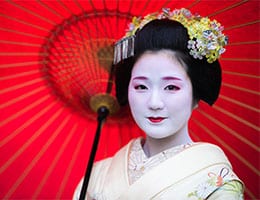 The etymological root of geisha is found in two words of the Japanese language : gei (which translates as “arts” ) and sha (translatable as “person” ). A geisha is a woman who, in Japan , was trained in the tea ceremony and in music and dance , allowing her to animate various social events.
The etymological root of geisha is found in two words of the Japanese language : gei (which translates as “arts” ) and sha (translatable as “person” ). A geisha is a woman who, in Japan , was trained in the tea ceremony and in music and dance , allowing her to animate various social events.
It can be said that a geisha is an artist trained since childhood or adolescence. Between the 18th and 19th centuries , a large number of Japanese women were geishas, while today the number of geishas has decreased.
Geishas were educated in special establishments ( geisha houses ). There, upon arriving, they fulfilled different assignments, assisted the most experienced and carried out cleaning tasks. Five or six years later, thanks to learning, they became entertainment professionals and were able to achieve some fame and recognition.
Geishas are often linked to prostitution. However, while their job may include flirting or advances when attending male gatherings, sexual activity is not part of their job. A geisha may agree to maintain an intimate relationship with a client, but that decision transcends the role of geisha.
In any case, there are speculations about these issues and even regarding the sale of a geisha's virginity . For this reason, especially in the Western world, it is common for a geisha to be mistakenly considered to be a prostitute.
It is worth mentioning that the work of the geisha does not only take place in men's gatherings, but can also be carried out for a group of women, or even mixed.
If we focus on the history of this Japanese concept, we will notice another very curious fact, which has little to do with the idea we have of it in the West: in the beginning, the majority of people who became geishas were men. This distances us even further from the relationship that many make between geisha and prostitute , although to distinguish both notions it is enough to know the multidisciplinary training that the former receive as a condition for assuming their role.
 One of the fundamental elements of the geisha performance is an incense that is used to measure the duration of the show: the entertainment ends when it is extinguished. In the past there was a clear distinction between city geishas and neighborhood geishas: although both entertained their audiences in the same way, making use of their vast artistic knowledge, the incense used by the latter lasted less, since their audience It was less numerous.
One of the fundamental elements of the geisha performance is an incense that is used to measure the duration of the show: the entertainment ends when it is extinguished. In the past there was a clear distinction between city geishas and neighborhood geishas: although both entertained their audiences in the same way, making use of their vast artistic knowledge, the incense used by the latter lasted less, since their audience It was less numerous.
The demand for geishas - and in this case we include both male and female geishas - grew as the artistic level of the courtesans decreased. In the 17th century, the courtesans' clients no longer hired them because they were upset that they were not free to travel to other districts , since they could not even leave their homes. This loss of interest meant the beginning of a new life for many of these women.
The reason why we currently link only women to the role of the geisha is because the number of men dedicated to this form of entertainment began to decline towards the 19th century. Over time, the Japanese themselves stopped associating the term with men.
As for the appearance of geishas, the look changes as the woman grows. Generally, the geisha makes up her face with a white base , with black and red decorations. The traditional clothing , meanwhile, is the kimono .
